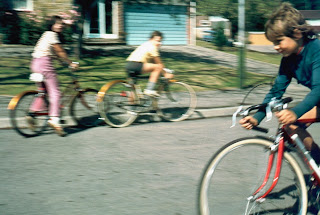Mark Cavendish and the tour of Britain.
Probably the best road race sprinter in the world.
Le tour has had a rest and so have I. Not posted on here since Friday to busy with bike riding and family stuff. I did however post some ideas about learning to sprint in group racing situations for a young lad on an old bike getting excited about racing. In this instance he was still using gear changers on the down tube which was made obsolete for serious racing by about 1989.
"RE tips for sprinting, the best training for this is to go out with a gang that treat village 30mph boundary signs or similar as the end of a bike race. I even know of a gang that has 'ahem' painted finish lines in the road. One great tactic is to sit just behind one of the other riders, this way they are working harder than you and then as you get the close to the finish give it everything and try and get past them. You'll probably need a slightly bigger gear than you need to 'sit on their wheel' Watch the finishes of the tour stages on the telly.
This type of situation is where your having friction levers on the down tubes is a disadvantage. Modern gears are much easier to change quickly in this type of situation.
If it's you on the front, try and position yourself so they can only pass you on one side. This makes it easier to spot the attack coming, giving you a chance to respond. Again having gears on the down tubes is a disadvantage, if they know what they're doing they will jump as soon as you start changing gear! My guess is many of the young racers these days wouldn't know this as they will not have raced much against people using these levers.
Danger
What is really important when sprinting, is to 'hold your line' DO NOT come across sideways into other riders that are passing you. Do not close somebody down against the Kurb or force them out into traffic coming the other way. Be predictable for the others. You will be reaching speeds where crashing is horrible.
Best thing, join a good club with people that train for road racing.
And don't blame me or anybody else if this all goes horribly wrong. Racing on bikes is aways a bit risky.... "












